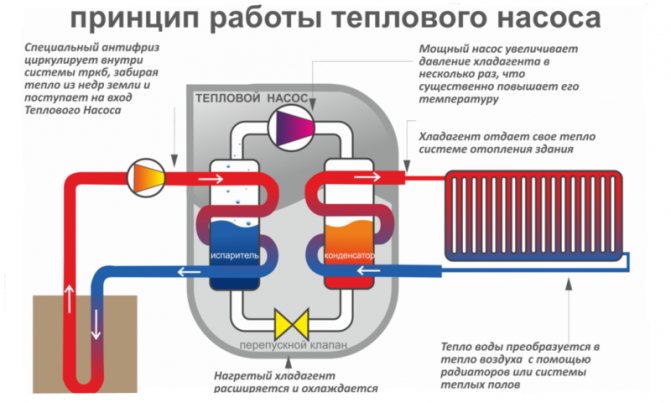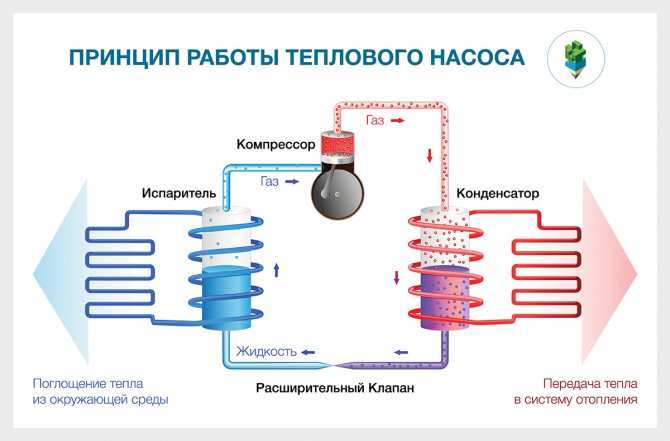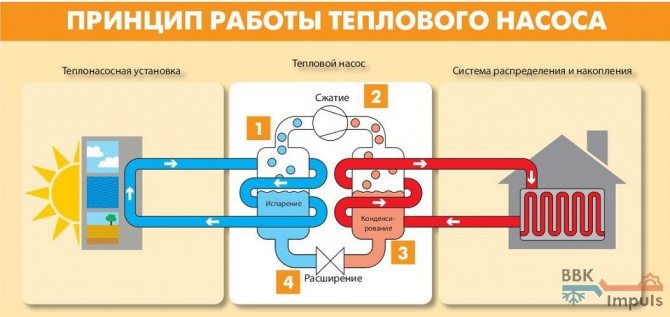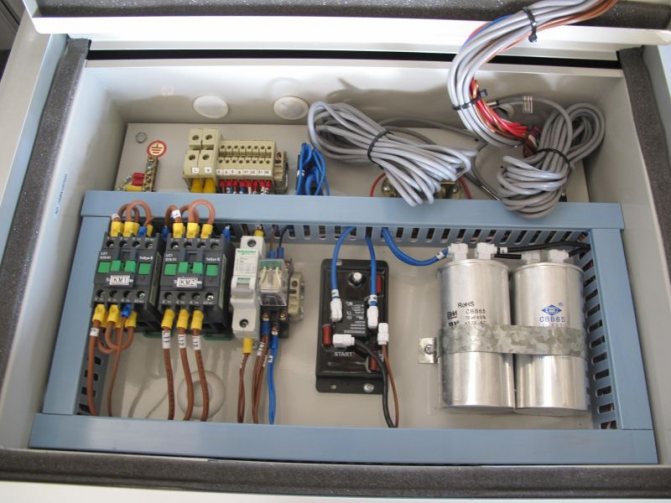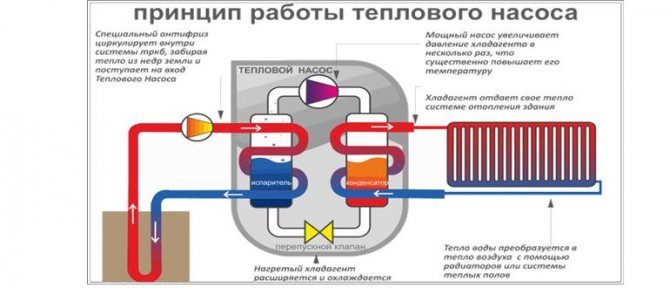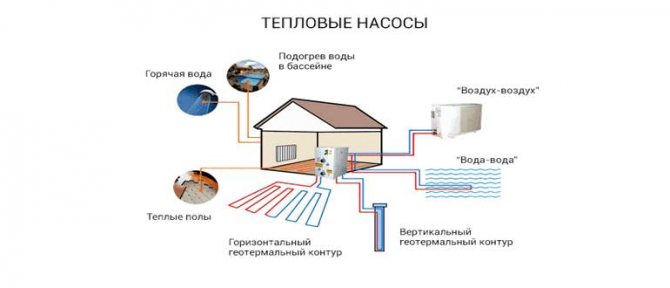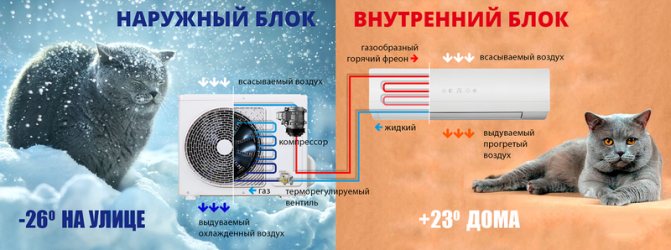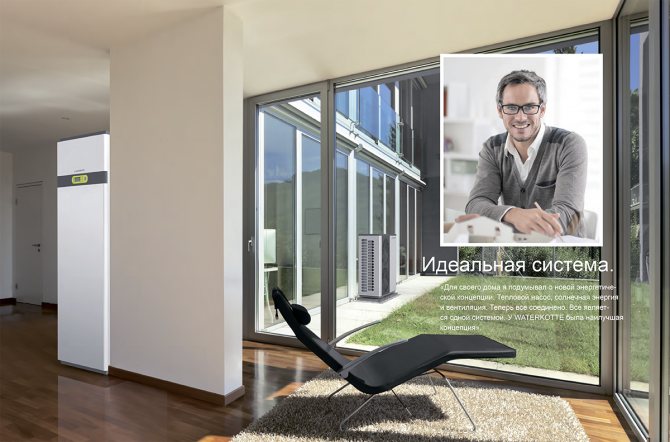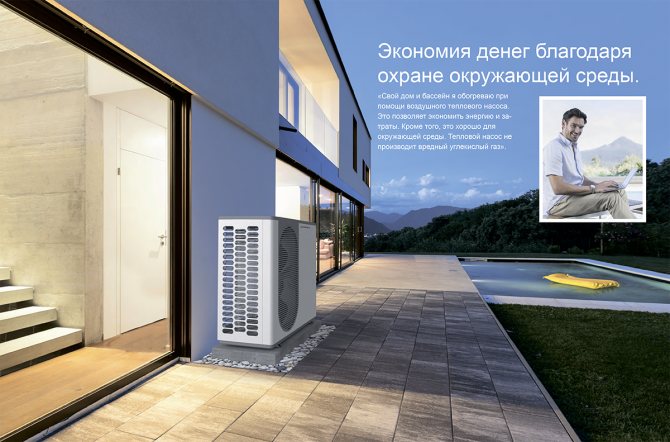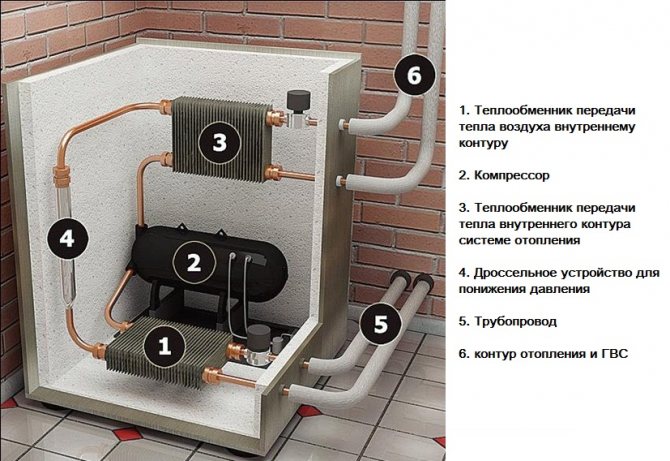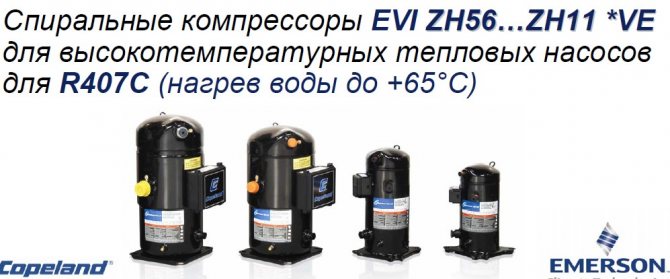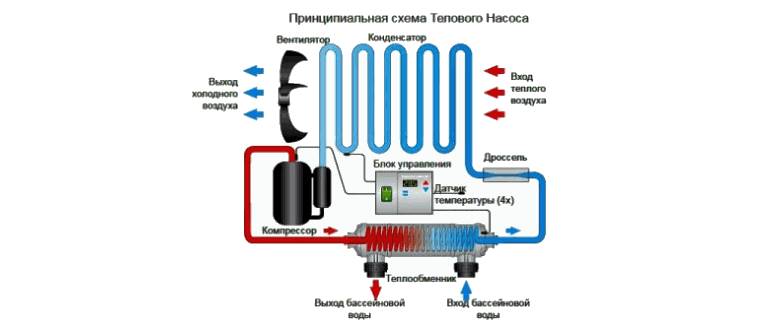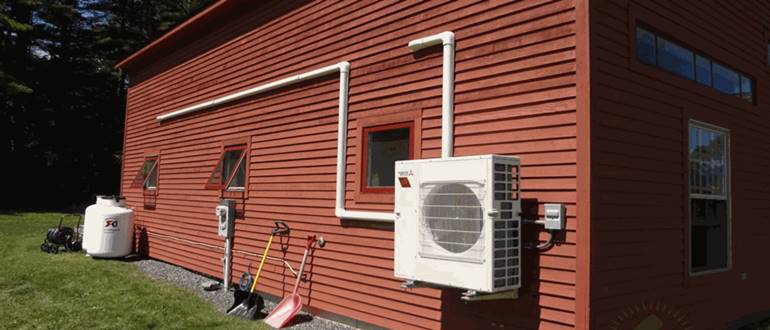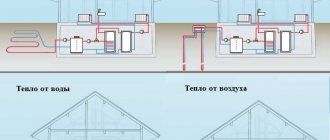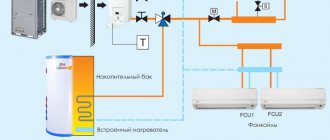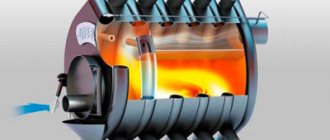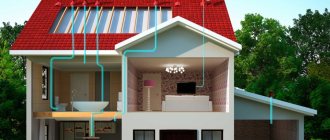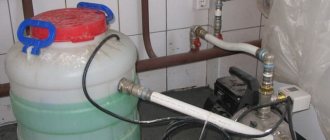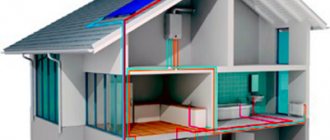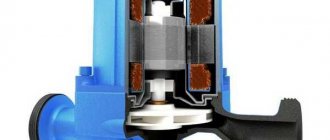A modern air-water heat pump is an extremely useful device. Even if the outside temperature approaches zero, it can successfully heat rather large rooms. If heat pumps of the "ground-to-water" or "water-to-water" type are easier to install in a private house with a spacious area, then the "air-to-water" model can be easily installed in urban buildings, both residential and office.
- 2 Advantages and disadvantages of such heating
- 3 Algorithm for assembling a homemade unit
- 4 A few words about power calculations
- 5 Correct maintenance technology
What do you need to know?
You can say that since heat pumps are so efficient, why are they so poorly used. The whole point lies in the high cost of equipment and installation. It is for this simple reason that many refuse this solution and choose, say, electric or coal-fired boilers. Nevertheless, it is not worth discarding this option for many reasons, which we will definitely mention in this article. Heat pumps, once installed, become very economical as they use the energy of the ground. The ground source pump is a 3 in 1. It combines not only a heating boiler and a DHW system, but also an air conditioner. Let's take a closer look at this equipment and consider all its strengths and weaknesses.
Outer part
The outdoor unit of the heat pump is located behind the air-transparent louvers. It is large enough and looks like an industrial air conditioner. In winter, the pump body freezes over and is covered with a dense snow coat. This is a process provided for in its work - according to its internal algorithms, the equipment regularly goes to defrost and completely thaws. After that, everything is repeated.

The principle of the unit
The principle of operation of a heat pump for heating is based on the use of the potential difference of thermal energy. That is why such equipment can be used in any environment. The main thing is that its temperature is at least 1 degree Celsius.
We have a coolant that moves through the pipeline, where, in fact, it heats up by 2-5 degrees. After that, the coolant enters the heat exchanger (internal circuit), where it releases the collected energy. At this time, there is a refrigerant in the external circuit, which has a low boiling point. Accordingly, it turns into gas. As it enters the compressor, the gas is compressed, as a result of which its temperature becomes even higher. Then the gas goes to the condenser, where it loses its heat, giving it to the heating system. The refrigerant becomes liquid and flows back to the external circuit.


Ground source heat pump: the lower the power, the cheaper the installation.
The investment cost is directly proportional to the thermal capacity of the installation. Therefore, despite the fact that the efficiency factor of the pump for groundwater does not decrease with the arrival of severe frost, it is worth considering the use of a heat pump in a bivalent system.
The easiest way is to equip it with an electric instantaneous water heater (as a rule, it is offered as an additional equipment - for installation in the heat pump housing). Then the bivalence point is determined and the required heat output of the pump is determined for it.
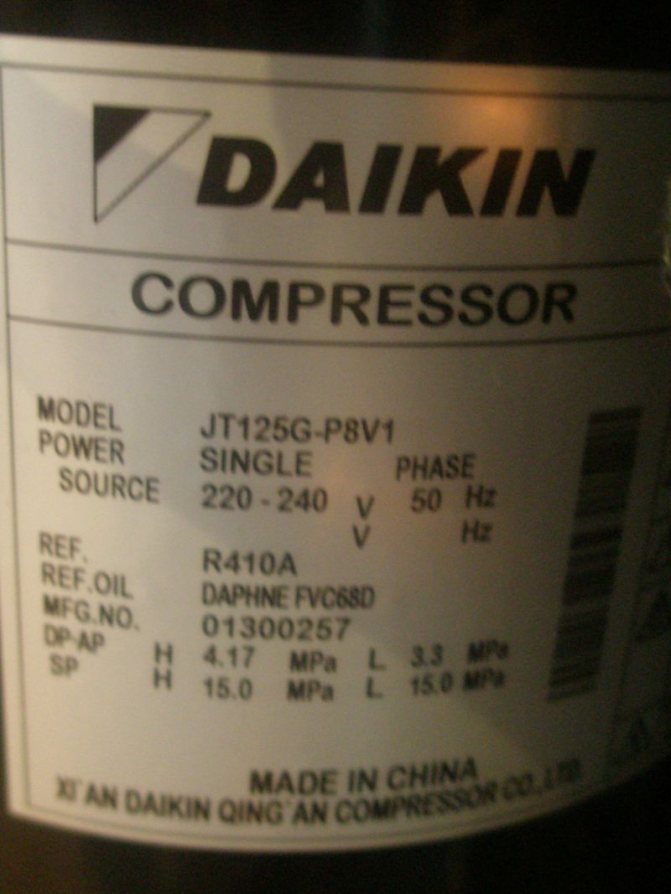

If the pump can heat a house located in the III climatic zone and it is assumed that an electric heater can move it below the outside air temperature of -10 degrees Celsius, then its thermal power can be 25% less of the design heat load.The cost of manufacturing a ground heat exchanger will be the same less.
In this example, instead of a power of 10.9 kW, 8.2 kW is sufficient. And, in this regard, the area of the horizontal heat exchanger can have 410 m2 instead of 545 m2 and the depth of the vertical one is 164 m instead of 218 meters. Apart from the lower price, the advantage is therefore also less space required.
Briefly about the types of heat pumps
Several popular geothermal pump designs are known today. But in any case, their principle of operation can be compared with the work of refrigeration equipment. That is why, regardless of the type, the pump can be used as an air conditioner in the summer. So, heat pumps are classified according to where they can extract heat from:
- From the ground;
- From the reservoir;
- Out of thin air.
The first type is most preferable in cold regions. The fact is that the air temperature often drops to -20 and below (for example, the Russian Federation), but the depth of soil freezing is usually insignificant. As for reservoirs, they are not everywhere, and it is not very advisable to use them. In any case, it is better to choose a ground source heat pump for home heating. We examined the principle of operation of the unit a little, so we go further.
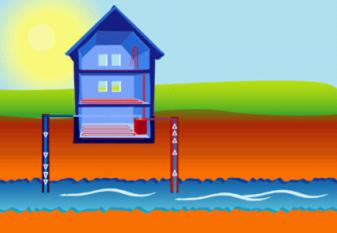

Heat pump Cooper & Hunter NORDIC PREMIUM (Inverter)
Description of the NORDIC PREMIUM series

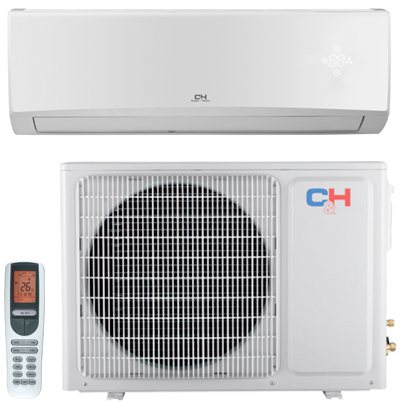
Class A ++- enlarged body for greater productivity and increased efficiency;
- elegant LED display, invisible when the device is turned off;
- Controlled by stepless control technology, the fan speed is adjustable in the range of 1% -100% from minimum to maximum speed;
- operating temperature range: from + 18 ° C to + 48 ° C for cooling, from -23 ° C to + 24 ° C for heating.
price-list for heat pumps of the NORDIC PREMIUM series in St. Petersburg
| Model | Room area, m2 | Productivity, kW | Electricity consumption, kW | Price, rub | ||
| cold | heat | cold | heat | |||
| CH-S09FTXN-PS (PW) | up to 25 | 2.64 | 3,00 | 0,56 (0,06-1,45) | 0,59 (0,14-1,55) | 61275 p. - (PS - Silver) 64575 p. - (PW - white) |
| CH-S12FTXN-PS (PW) | up to 35 | 3,52 | 3,90 | 0,77 (0,06-1,56) | 0,80 (0,1-1,65) | 62250 RUB - (PS - Silver) 67800 p. - (PW - white) |
| CH-S18FTXN-PS (PW) | up to 55 | 5,30 | 5,60 | 1,19 (0,10-2,46) | 1,19 (0,20-2,30) | |
| CH-S24FTXN-PS (PW) | up to 70 | 6,60 | 6,80 | 1,50 (0,10-2,80) | 1,45 (0,21-2,50) | |
"Ground-water": how best to place it?
Getting heat from the ground is considered the most appropriate and rational. This is due to the fact that there are practically no temperature fluctuations at a depth of 5 meters. A special fluid is used as a heat carrier. It is commonly called brine. It is completely environmentally friendly.
As for the placement method, that is, horizontal and vertical. The first type is characterized by the fact that the plastic pipes, which represent the outer contour, are laid horizontally on the square. This is very problematic, since the laying work must be carried out on an area of 25-50 square meters. In the case of vertical wells, vertical wells are drilled with a depth of 50-150 meters. The deeper the probes are placed, the more efficient the geothermal heat pump will work. We have already considered the principle of operation, and now we will talk about important details.
Mobile heat pumps Cooper & Hunter
Mobile air conditioner, Low noise level, Protection against fire, 5-levels of protective coating "V-protect",
Description of the MOBILE series
- "Cold Plasma" - a new generation of total air purification technology;
- Special design for professional installations;
- Increased resource of work;
- Low noise level;
- Highest energy efficiency class A;
- Compact laconic design;
- Displaying the current time of day on the remote control;
- Compact hi-tech design
price-list for Mobile heat pumps Cooper & Hunter
| Model | Room area, m2 | Productivity, kW | Electricity consumption, kW | Price, rub | ||
| cold | heat | cold | heat | |||
| CH-M09K6S | up to 25 | 2,64 | 2,64 | 38900 | ||
| CH-M12K6B | up to 35 | 3,52 | 3,52 | 55500 | ||
| CH-M12K7S | up to 35 | 3,52 | 3,52 | 55500 | ||
| CH-M10K7B | up to 30 | 2,93 | 2,93 | 48500 | ||
| CH-M10K7S | up to 30 | 2,93 | 2,93 | 48500 | ||
You can buy a Cooper and Hunter heat pump air conditioner in our office in St. Petersburg. Prices for heat pump air conditioners Cooper and Hunter are listed above. It is also possible to purchase a heat pump-air conditioner Cooper and Hunter with installation.
Heat pump "Water-to-water": principle of operation
Also, do not immediately discard the possibility of using the kinetic energy of water. The fact is that at great depths the temperature remains quite high and varies in small ranges, if this happens at all. You can go several ways and use:
- Open bodies of water such as rivers and lakes.
- Groundwater (well, well).
- Waste water from industrial cycles (return water supply).
From an economic and technical point of view, the easiest way is to set up the operation of a geothermal pump in an open reservoir. At the same time, there are no significant structural differences between the pumps "soil-water" and "water-water". In the latter case, pipes immersed in an open reservoir are supplied with a load. With regard to the use of groundwater, the design and installation are more complex. It is necessary to allocate a separate well for water discharge.
The principle of operation of the air-to-water heat pump
This type of pump is considered one of the least efficient for a variety of reasons. First, in the cold season, the temperature of the air masses drops significantly. Ultimately, this leads to a decrease in pump power. It may not be able to cope with heating a large house. Secondly, the design is more complex and less reliable. However, installation and maintenance costs are significantly reduced. This is due to the fact that you do not need a reservoir, a well, and you do not need to dig trenches for pipes at your summer cottage.
The system is placed on the roof of the building or in another suitable place. It is worth noting that this design has one significant plus. It consists in the possibility of using exhaust gases, air that leaves the room again. This can compensate for the insufficient capacity of the equipment in the winter.
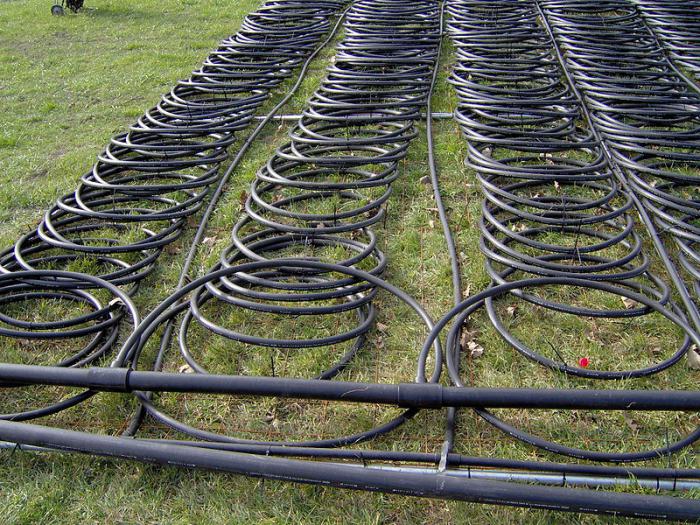

Conclusions based on the results of use
The entire turnkey ventilation and heating system cost about 280,000 rubles. Here it is necessary to take into account that the work was carried out on our own, and when purchasing equipment and materials, the talents of "knocking out" discounts were used to the maximum.
Many do not believe that in our latitudes it is possible to heat the air heated by electricity. From our own experience, we can say that this is real. Such systems work and even save money. The average monthly amount for heating in our country is 6000-8000 rubles. From the experience of neighbors with houses of a similar size, we know that they pay both 20,000 and 25,000 rubles a month. It turns out that all our costs for installing an air-to-air heat pump will fully pay off in about 2 years.
Air-to-air pumps and more
Such installations are even less common than "Air-Water", for a number of reasons. As you may have guessed, in our case, air is used as a heat carrier, which is heated from a warmer air mass from the environment. There are a large number of disadvantages of such a system, ranging from low productivity to high cost. An air-to-air heat pump, the principle of which you know, is not bad only in warm regions.
There are strengths here as well. First, the low cost of the coolant. Chances are, you will not encounter an air line leak. Secondly, the effectiveness of such a solution is extremely high in the spring-autumn period. In winter, it is impractical to use an air heat pump, the principle of operation of which we have considered.
The advantages and disadvantages of such heating
A modern air-to-water heat pump is efficient and allows you to significantly save on heating, because:
- air can be called the most accessible and cheapest renewable resource;
- the cost of installing such a unit will be cheaper than installing other types of heat pump (soil-water, water-water, etc.), and the whole process is easier and faster;
- heating can be carried out even at negative outside temperatures;
- the device works almost silently;
- provides effective air exchange inside the room;
- the installation can be controlled in automatic mode.
Indeed, when constructing an air heat pump, you do not need to drill wells or carry out large-scale excavation, you do not need to build a heat exchanger for the external circuit, etc. You will need two small channels through which air will be taken in and then returned to the outside. For this, two small insulated pipelines are laid in the ground. There are also models that do not need such pipelines.
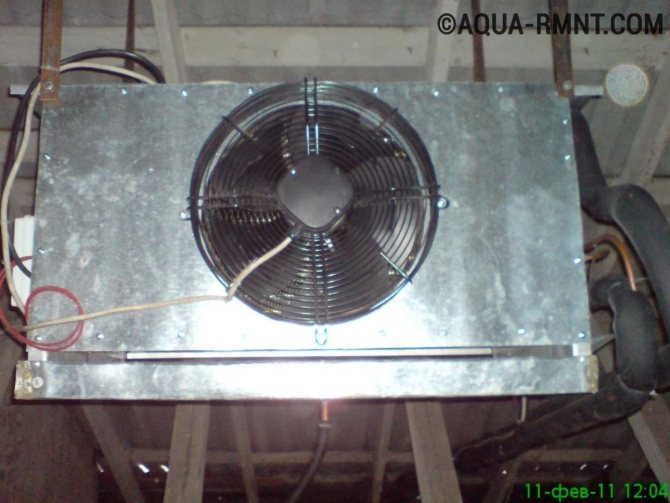

An air-to-water heat pump will require a large fan to supply air to the evaporator. Fan blades must be covered with a grill
There are few disadvantages of this design, but they should be taken into account. Although it is believed that an air heat pump can work efficiently all year round, it is still better to use it in an area with mild and warm winters. It is not recommended to turn on such a heat pump at temperatures below -7 degrees. At the same time, the efficiency of the system in winter will be lower than in spring or autumn. Although manufacturers claim that industrial models of heat pumps of this type can work quite successfully even at -25 Celsius. In an area with a harsh climate, the most profitable option may be a combination of a heat pump and a traditional heating boiler, which turns on only when severe cold weather sets in.
Of course, any heat pump requires electricity to operate. For each kilowatt of electricity consumed, the device allows you to get 3-4 kW of natural energy. Therefore, in the end, the use of a heat pump for heating is economically profitable compared to the cost of heating with gas, diesel, solid fuel or heating with an electric boiler. However, you should not forget about the dependence of the system on the availability of electricity.
Homemade heat pump
Studies have shown that the payback period of the equipment directly depends on the heated area. If we are talking about a house of 400 square meters, then this is approximately 2-2.5 years. But for those who have smaller housing, it is quite possible to use homemade pumps. It may seem that it is difficult to make such equipment, but in reality it is somewhat different. It is enough to purchase the necessary components, and you can proceed with the installation.
The first step is to purchase a compressor. You can take the one on the air conditioner. Mount it in the same way on the wall of the building. In addition, a capacitor is needed. You can build it yourself or buy it. If you go with the first method, you will need a copper coil with a thickness of at least 1 mm, it is placed in the case. It can be a tank of a suitable size. After installation, the tank is welded and the necessary threaded connections are made.
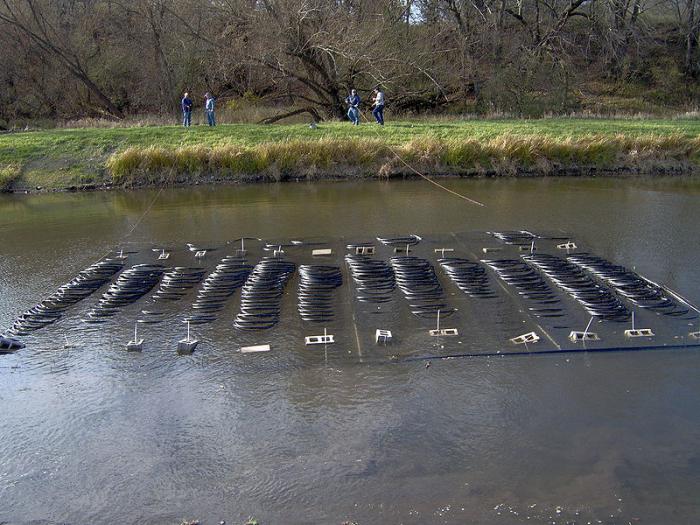

Heat pump Cooper & Hunter VERITAS
New for 2020! "CH 7-SKY Technology" - a comprehensive filtration system based on seven broad-spectrum filters, "CH SMART-ION Filter" - a new generation of total air purification technology, exclusive design of the indoor unit, operation for cooling down to -24 ° C for heat up to -15 ° C. Function "+ 8 ° C". Premium energy-saving GENERATON IV equipment (increased quality control of assembly and materials), remote control backlight for convenient use in the dark. Wi-Fi module for control via smartphone / tablet. Advanced software that optimizes the operation of the air conditioner over a wide range of compressor speeds
Description of the VERITAS series
- Class A ++ Inverter;
- "CH 7-SKY Technology" - a complex filtration system based on seven filters of a wide spectrum of action;
- "CH SMART-ION Filter" - a new generation total air purification technology;
- Temperature range of effective work from -15 ° C to + 24 ° C for heat, from -15 ° C to + 48 ° C for cold;
- Premium energy-saving complete set "GENERATON V" (increased quality control of assembly and materials);
- Self-cleaning of the indoor unit;
- Wide-angle blinds that cover the entire volume of the room.
price-list for heat pumps of the VERITAS series in St. Petersburg
| Model | Room area, m2 | Productivity, kW | Electricity consumption, kW | Price, rub | ||
| cold | heat | cold | heat | |||
| CH-S07FTXQ | up to 20 | 2,2 | 2,3 | 0,61 | 0,6 | 37350 |
| CH-S09FTXQ | up to 25 | 2,6 | 2,8 | 0,72 | 0,73 | 42375 |
| CH-S12FTXQ | up to 35 | 3,5 | 3,6 | 0,97 | 0,95 | 44925 |
| CH-S18FTXQ | up to 55 | 5 | 5,3 | 1,43 | 1,38 | 63375 |
| CH-S24FTXQ | up to 70 | 6,7 | 7,25 | 1,88 | 1,95 | 92400 |
The final part of the work
In any case, at the final stage, you will need to hire a specialist. It is a knowledgeable person who must solder copper pipes, pump freon, and also start the compressor for the first time. After assembling the entire structure, it is connected to the internal heating system. The outdoor circuit is installed last, and its features depend on the type of heat pump used.
Do not overlook such an important point as replacing outdated or damaged wiring in the house. Experts recommend installing a meter with a capacity of at least 40 amperes, which should be quite enough for the operation of a heat pump. It will not be superfluous to note that in some cases such equipment does not live up to expectations. This is due, in particular, to inaccurate thermodynamic calculations. So that it does not happen that you spent a lot of money on heating, and in the winter you had to install a coal boiler, contact trusted organizations with positive reviews.


Coolant circulation schemes
When operating a heat pump (HP), three closed circuits are used through which various liquids / gases circulate - heat carriers. Each of them performs its own functions.
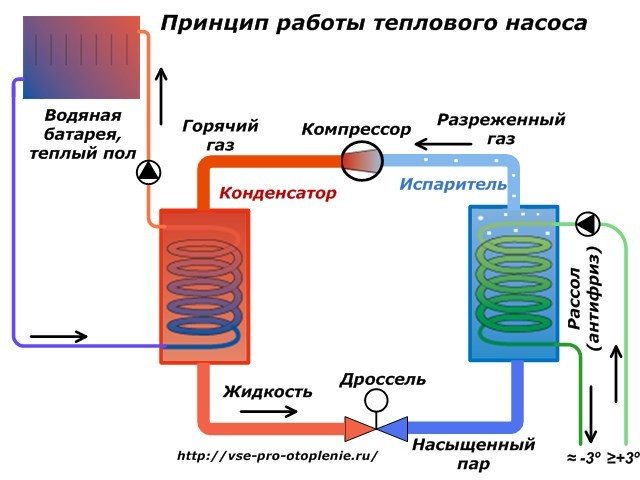

Loop for picking up the potential of the energy source
When air heat is taken, artificial blowing of the evaporator housing with air flows from the fans is used.
A closed cycle of a heat transfer fluid for transferring heat to an aquatic environment or earth is carried out through pipelines that connect the evaporator coil to a collector recessed to the bottom of the reservoir or buried in the ground at a distance exceeding the freezing of the soil in severe cold weather.
Antifreeze liquids based on dilute aqueous solutions of alcohol are used as a heat carrier. They are commonly called "antifreezes" or "brines". Under the influence of a higher temperature (≥ + 3 ° C), they rise to the evaporator, transfer heat to it, and after cooling (≈-3 ° C) are directed back to the energy source by gravity, providing continuous circulation.
Inner contour
A freon-based refrigerant circulates through it, "raising" the heat to a higher level. Under the influence of temperature, it sequentially passes into a gaseous and a liquid state.
The inner contour includes:
- an evaporator that takes energy from brines and transfers it to freon, which boils at the same time and becomes a rarefied gas;
- a compressor that compresses gas to high pressure. At the same time, the freon temperature increases sharply;
- a condenser, in which the hot gas transfers its energy to the coolant of the outlet circuit, and itself cools down, passing into a liquid state;
- throttle (expansion valve), which reduces freon due to the pressure drop to the state of saturated steam for entering the evaporator. As the refrigerant flows through the narrow opening, the pressure of the heating medium drops to the initial value.
Output circuit
Water circulates here. It is heated in a condenser coil for use in a conventional liquid heating system.With this method, its temperature reaches about 35 ° C, which makes it suitable for use in the "Warm floor" system with long lines that allow the generated energy to be evenly transmitted to the entire volume of the room.
Using only heating radiators, which create less heat exchange with the space of the rooms, is not so effective.
Safety and environmental friendliness above all
Heating with the pumps described in this article is one of the most environmentally friendly methods. This is mainly due to the reduction of carbon dioxide emissions into the atmosphere, as well as the conservation of non-renewable energy resources. By the way, in our case, renewable resources are used, so there is no need to be afraid that the heat will suddenly end. Thanks to the use of a substance that boils at low temperatures, it became possible to realize the reverse thermodynamic cycle and, with less energy, get a sufficient amount of heat into the house. As for fire safety, then everything is clear. There is no possibility of gas or fuel oil leakage, explosion, no dangerous places for storing flammable materials and much more. In this regard, heat pumps are very good.
Equipment operating parameters
Severe frosts in the Moscow region are rare, experience has shown that the temperature rarely drops below -25 ℃. It was calculated that in such conditions a pump that produces 15 kW of heat will be enough for the house of the available area. The system budget cost us about 150,000 rubles.
The efficiency of air pumps also changes depending on external conditions. In our case, it turned out that with the consumption of 1 kilowatt-hour of electricity, the system produced 2-2.5 kW of heat. It's minimum. If there is a light thaw outside with a temperature slightly above zero, then it gives out 3.5 kW of heat.
The house is evenly warmed up by the warm air, there are no radiators or warm floors. Fresh outside air is constantly added to the system through the recuperator.


The recuperator's task is to additionally save heat. With its help, the air coming from the street is heated by the one that is forcibly thrown out of the house, for example, from the bathrooms. The desired room temperature is set on the remote control.


Automatic control, at night the temperature is reduced for greater comfort.

